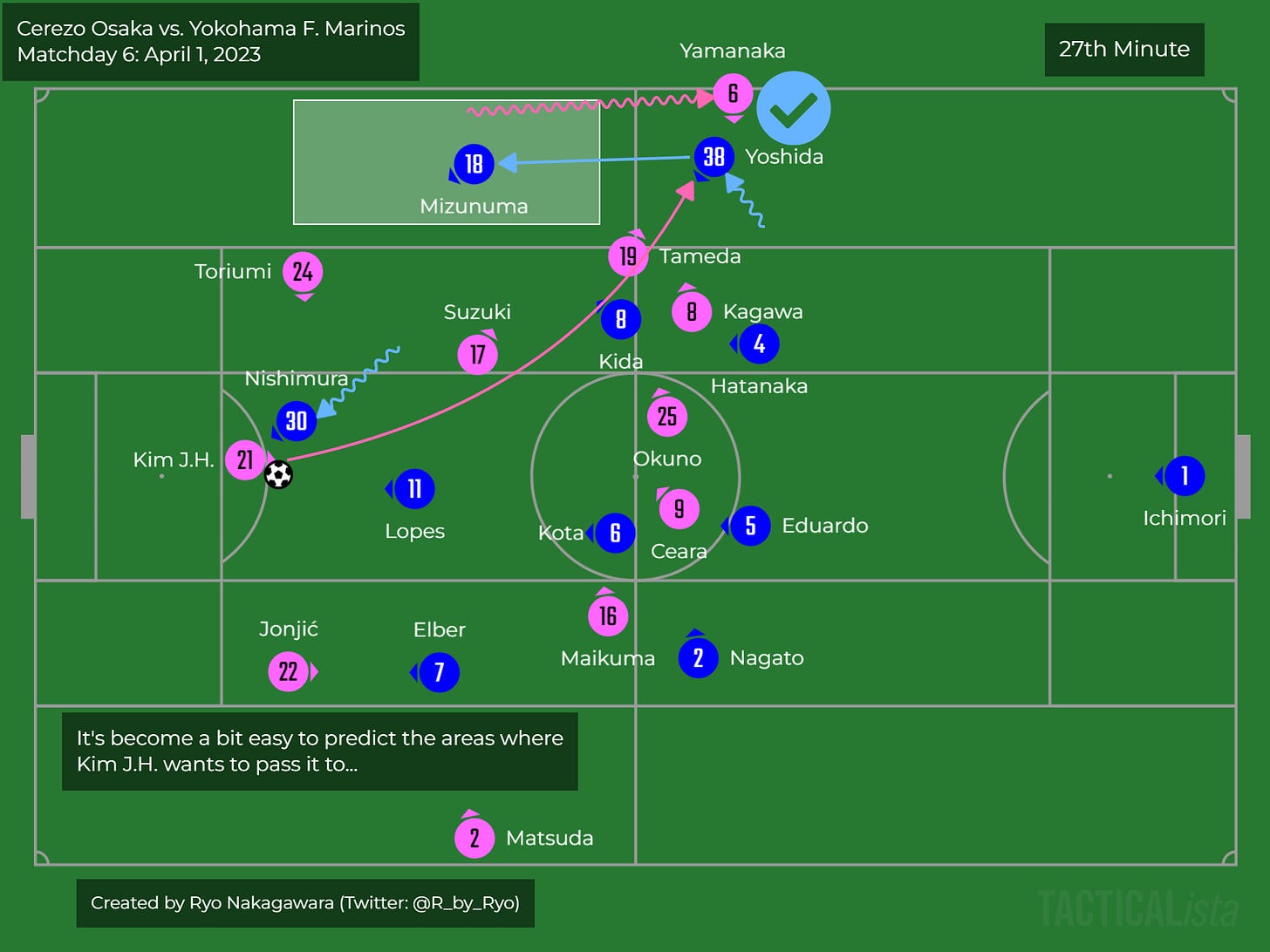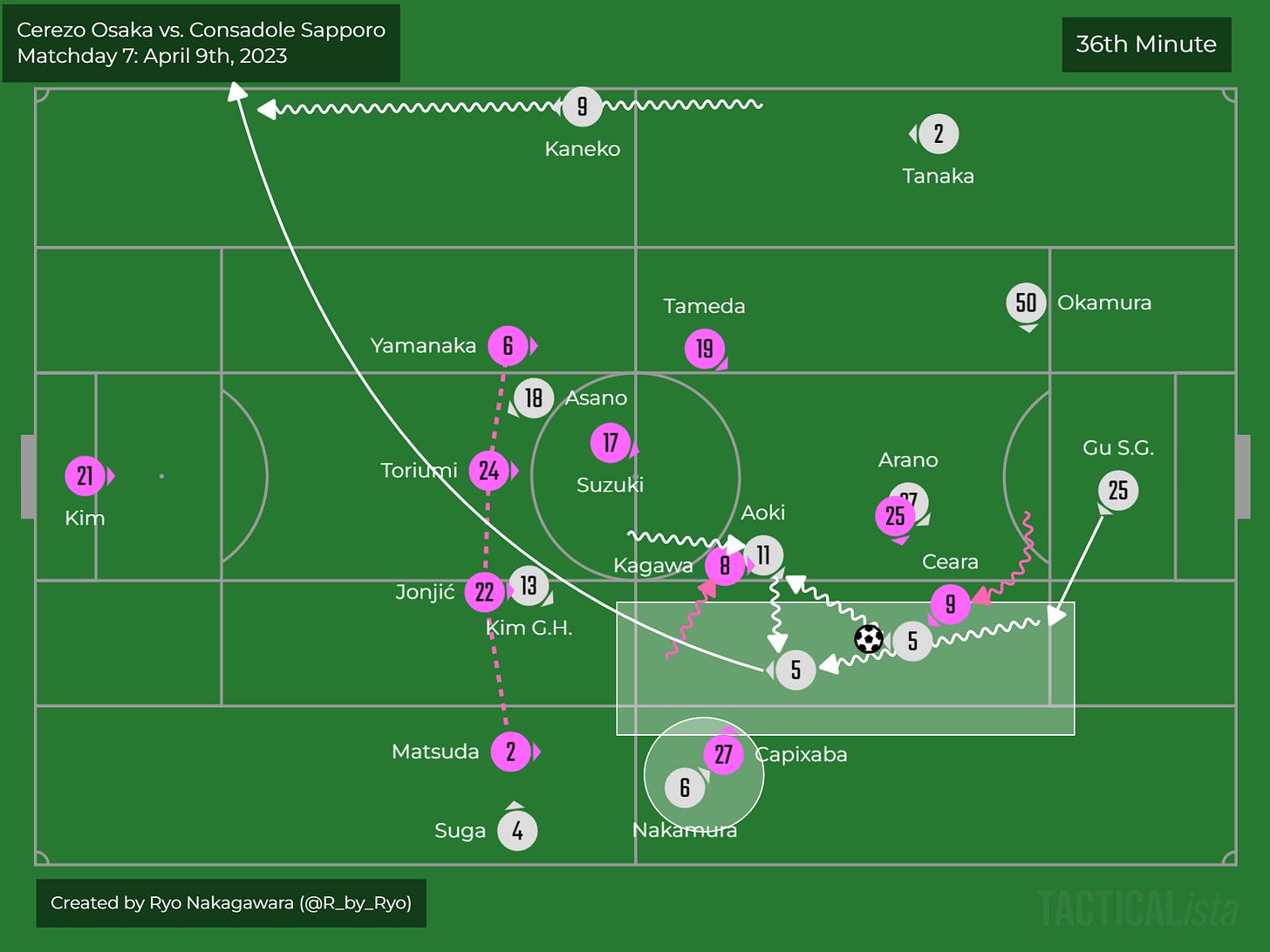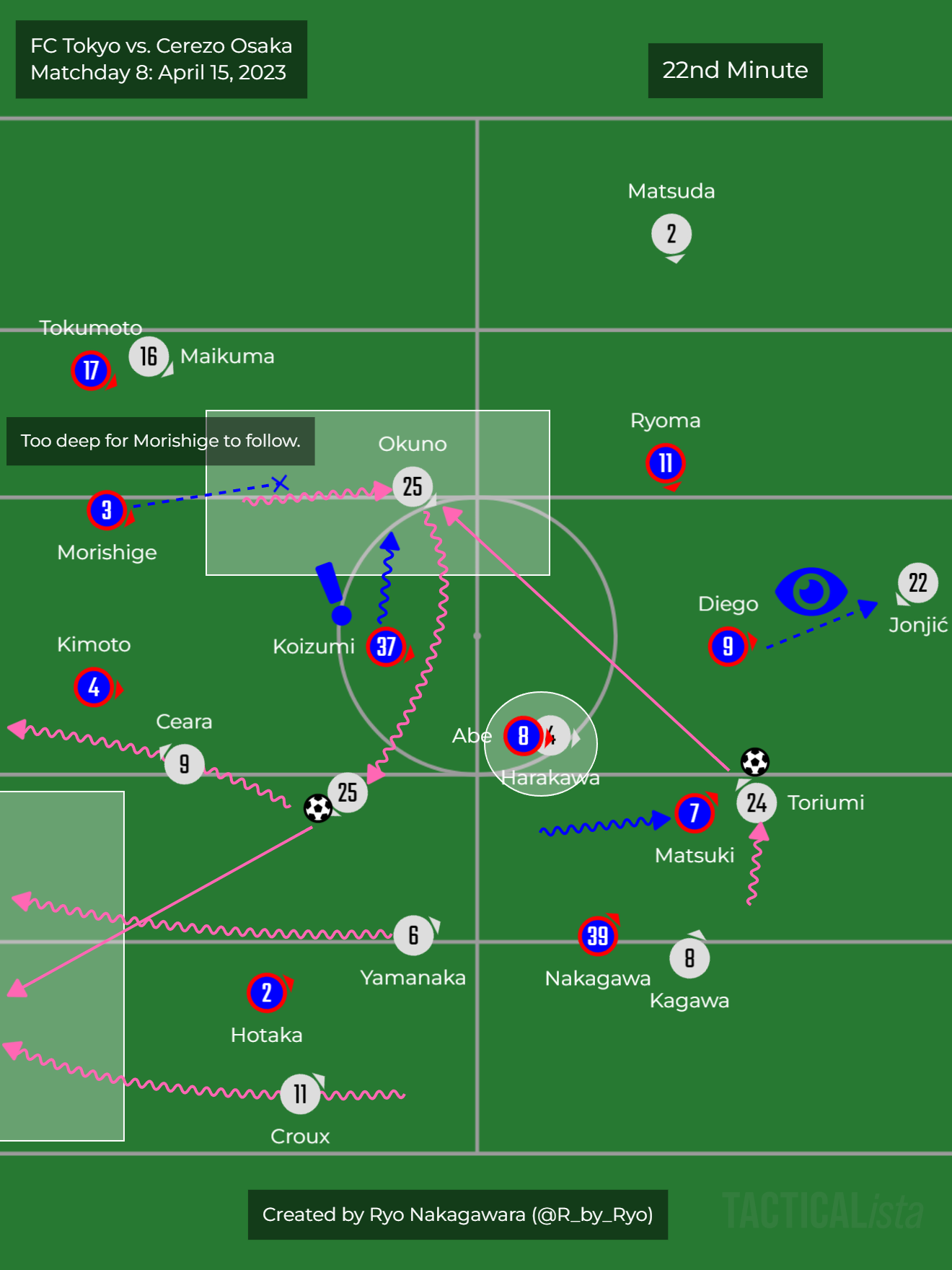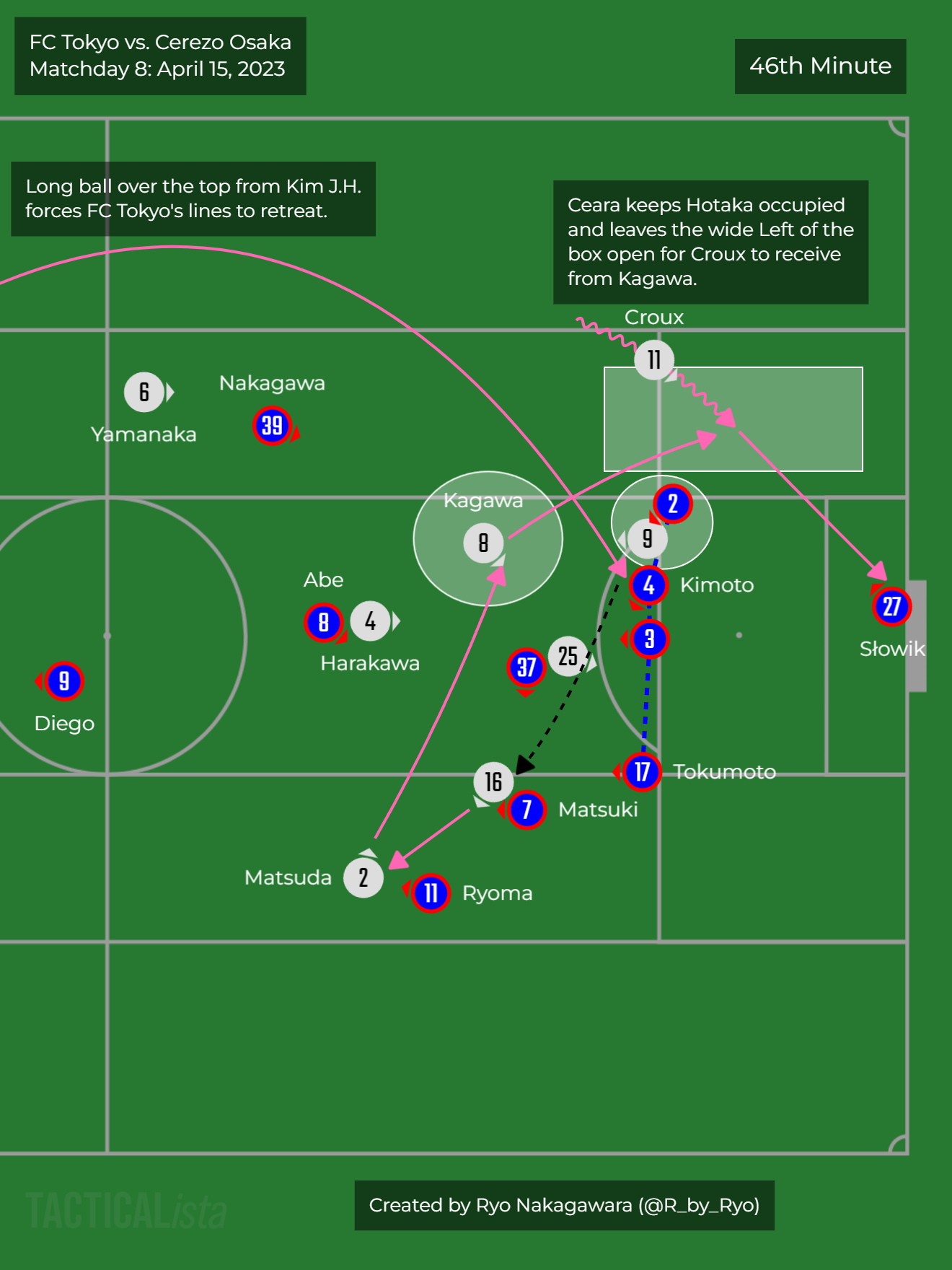J.League 2023 Matchday 8, Tactical Review: FC Tokyo vs. Cerezo Osaka
When it rains, it pours... at Ajinomoto Stadium.
Hello, it’s been a while. I’ve been very busy but I’m back now with another tactical review, this time on FC Tokyo vs. Cerezo Osaka. I’ve still been able to watch and take notes on most games but I haven’t had time to sit down and write out full reviews lately (or at least in any length or depth that I would be happy with…). Still, I think providing a bit more content, even if it isn’t as in-depth as my usual fare, would still be in the interest of most of y’all so I am considering posting “smaller” reviews and just “general impressions” of games on Substack NOTES. Let me know in the comments on what you think about that.
Anyway, let’s get started!
FC Tokyo in recent weeks…
MD #6, April 1st: vs. Sagan Tosu (L: 0-1)
Shuhei Tokumoto’s introduction to the team (in league play) had a very positive effect of making the build-up on the Left side very smooth.
However, it was after getting the ball past the 1st or even 2nd line of the Tosu’s press where poor mistakes made sure that Tokyo couldn’t get into the final 3rd, let alone the opposition box.
Compared to previous games, both Trevisan and Slowik were much more pro-active in trying to find forward passes rather than sideways. Nevertheless, a lot of the time Tosu were able to press Tokyo to pass it out wide, pin Tokyo against the sideline, and force the Tokyo defenders to kick it away long.
Teruhito Nakagawa cut a frustrated figure as he consistently made good runs or passes but his Tokyo teammates don’t seem to be on his wavelength.
Unfortunately another pass mistake from Slowik, and more inexcusably, an even worse attempt to make the save led to Tosu grabbing the winner in the last seconds of the game…
MD #7, April 9th: vs. Shonan Bellmare (D: 2-2)
As usual from Shonan, they pressed FC Tokyo’s back-line very hard and made it difficult to build-up from the back. However, there were several scenes where FC Tokyo were able to progress up the field regardless which can be taken as a positive. Indeed, the opening goal in the 29th minute was a perfect example of FC Tokyo going from the back-to-the-front and Nakagawa scored on the rebound of Matsuki’s shot inside the box.
Still, the opening goal was definitely against the run of play as Shonan continued to pile on the pressure all half long. Shonan spent significant amounts of time pushing into FC Tokyo’s defensive 3rd as they threw wave after wave of players in the wide areas to overload Tokyo’s defenders.
The 2nd Half continued in the same vein, with Shonan continuing to cause FC Tokyo problems with their high intensity press. This resulted in two quick-fire goals for Shonan to turn the game around as they forced FC Tokyo into mistakes and punished them.
FC Tokyo managed to claw back a goal through Trevisan’s gigantic leap for a header on a free kick. Otherwise, Tokyo quickly changed strategy to throwing Adailton on and trying to overcome Shonan’s defense quickly in transition rather than through possession play.
Both teams had chances but it finished in a draw.
Cerezo Osaka in recent weeks…
MD #6, April 1st: vs. Marinos (W: 2-1)
Marinos controlled the game for the most part and looked the better team. Marinos were able to break past Cerezo’s first and second lines of defense as Kota Watanabe and Takuya Kida deftly positioned themselves in the gaps between Cerezo’s midfield 3 to progress the ball. However, Cerezo managed to defend well when play came into the defensive 3rd as the sheer number of players tracking back blocked options inside for Marinos in the final 3rd. Even when hit on the counterattack, Cerezo were very quick and at the very least, slowed down Marinos’ attacks if not outright win possession.
Cerezo barely managed to keep the ball and were stuck defending in a 4-5-1 mid-block that would only occasionally sally forth to disrupt Marinos’ build-up. Still, hard work from Leo Ceara and Okuno made sure they made the most out of the few chances they got and they went into halftime with a 2-0 scoreline that came completely against the run of play.
2nd Half continued with Marinos piling on even more pressure but they couldn’t create a whole lot of clear cut chances and Cerezo were mainly playing somewhat effectively on the counterattack. In the 82nd minute, Marinos got one goal back in a very silky sequence down the Left but it was too little too late.
MD #7, April 9th: vs. Consadole Sapporo (L: 2-3)
The game started off with lots of long balls or clearances from both teams as both teams tried to gain territory in the opponent half of the field. Sapporo were using these long balls as a chance to also counter-press from high up the pitch if they couldn’t win the initial duels in the air.
Cerezo were giving Sapporo’s Center Backs time on the ball, which led to a large volume of long diagonal or vertical balls into the final 3rd that Cerezo had to deal with, disorienting their compact lines and getting the ball out wide where Sapporo’s most dangerous players were. This made it easy for Sapporo to find spaces to dribble or pass into when they won the ball in Cerezo’s half on the counter.
Despite decent spells in possession throughout the game (mainly as Sapporo were a bit lax in their man-marking scheme, especially in the First Half…), Cerezo didn’t really create any meaningful chances except for their 2nd goal and the game petered out to a fairly comfortable finish for Sapporo.
Starting line-ups
With Kashif’s injury in last month’s international fixtures, Shuhei Tokumoto continues to keep his place at Left Back. Masato Morishige comes in for Trevisan at Left Center Back.
Shuto Abe makes his first start since his return from injury, taking up the #10 spot with Keigo Higashi making way and Tokyo’s midfield shifts to more of a “double-pivot + #10” shape. Ryoma Watanabe also returns from injury to replace Tawaratsumida out wide.
Riki Harakawa replaces Tokuma Suzuki at the base of midfield while Capixaba replaces Tameda at Left Midfield.
First Half
FC Tokyo were able to find some time on the ball, especially their Center Backs, in the build-up as Cerezo didn’t press very high and usually left Leo Ceara by himself while the rest of the team retreated into a 4-5-1 mid-block. On occasions Okuno and Kagawa would push up to harass the Tokyo Center Backs alongside Ceara but mainly kept themselves deeper to guard the passing lanes in the half-spaces.
This meant that compared to the Shonan or Tosu game, Yasuki Kimoto in particular, had a lot of time to pick out passes from the back. With the likes of Hotaka Nakamura inverting into the half-space, FC Tokyo were especially able to progress down the wide areas as the Fullback’s narrow positioning kept Cerezo’s wide midfielders narrow and leave the outside lanes open for the wingers to receive. The wingers were well positioned so that it was hard for Cerezo’s Full Backs to step up to pressure the winger themselves, and even when they did, Teruhito Nakagawa had the skills to evade the pressure and create dangerous moments by then playing into the space that the Full Back vacated.
It wasn’t all easy-going for FC Tokyo, however, as there were a few times that Cerezo were able to either press-and-dispossess or cut out the vertical passes from the defense to FC Tokyo’s midfield and threaten on the counterattack. Riki Harakawa tracked back quickly and tackled or intercepted, he was probably Cerezo’s best player on the day (13:20, 23:00, 37:30).
Cerezo’s main avenues of attack were the long balls from the goalkeeper, Kim J.H., to players out wide as usual. However, like in 18:20, FC Tokyo were alert and managed to intercept these mid-range passes into the Full Backs stationed around the middle 3rd of the pitch.
Cerezo were having a hard time progressing the ball centrally despite having their 3 midfielders all moving around, fluidly changing their shape between a 1-2 and 2-1 (or inverted triangle and triangle midfield). The only real time they were able to do so in the First Half was in the 22nd minute, when Okuno drifted into a pocket of space for Toriumi to pick out.
As usual, this Cerezo attack ended in a crossing situation. But otherwise, FC Tokyo’s midfield were diligent in catching their opponents (Matsuki and Koizumi were very good at shifting over from side-to-side to cover the passing lanes as well) and also pressed the initial passers in the build-up (usually the Center Backs) pretty quickly to force them to go long.
As mentioned previously, Cerezo weren’t pressing too much and preferring to keep a tight 4-5-1 mid-block with only occasional sorties by one (or both) of the advanced midfielders. Indeed, when Cerezo attempted to take the risk and push up in numbers, they left gaps in midfield on either side of Riki Harakawa. This was exploited in the 40th minute when Kimoto was able to spread it wide to Hotaka Nakamura and then Matsuki was positioned in the Right half-space to receive with time and space to take a shot from the top of the box.
The First Half ended in a 0-0 stalemate. FC Tokyo looked like the slightly better team but still unable to create clear-cut chances despite being able to enter the final 3rd. Meanwhile Cerezo’s chances mainly came in transition when they clamped down quickly when the ball came into the central areas for FC Tokyo’s midfielders dropping back to receive, but otherwise they struggled in possession.
Second Half
Cerezo were able to progress the ball through the midfield a bit better in the Second Half, not so much that they were particularly dominant but it was an improvement over the First Half. Both Kagawa and Okuno were taking more risks and pushing up while it should also be noted that I think Tokyo’s midfield tired a bit as the Second Half wore on and couldn’t press the ball-holder or shut down the pass receiver as quickly as they did in the First Half.
The key improvement for Cerezo was being able to create more time on the ball for themselves and evade Tokyo’s high press through quick combinations or simply booting it up to Leo Ceara. Also they got their Full Backs into the game as they were able to receive high-and-wide a lot more in the Second Half (56:32, 61:15, 65:10).
Otherwise, things remained fairly similar to the First Half as FC Tokyo’s Center Backs still had time and space to play the ball to the wings as Cerezo’s shape remained very narrow and compact horizontally.
(Note: If you’re outside Japan you’ll most likely need a VPN to watch the linked videos, sorry.)50:51
The goal to break the deadlock came about from a Cerezo specialty, set-pieces. Yamanaka put in an excellent low cross from the Left and Okuno (among other Cerezo players) beat the offside trap with a well-timed run toward the near post and touched the ball on past Slowik into the net. 1-0.
58:55
FC Tokyo replied quickly as Shuto Abe beat Harakawa to a loose ball in the middle of the park and sent Hotaka Nakamura down the Right Wing. As Hotaka entered the final 3rd, Ryoma Watanabe made a run in the Right half-space to receive the ball between Cerezo’s quickly retreating Defense and Midfield lines. Ryoma chested the ball and volleyed home a sublime finish to tie up the game.
67:20
FC Tokyo brought on Kota Tawaratsumida out wide and he created a very good chance in the 80th minute:
However, the game would end in Cerezo’s favor as Shinji Kagawa was able to receive in acres of space in the center of the field as Tokyo’s double-pivot retreated to help the defense and so he was able drive past the halfway line under little pressure. He found Yamanaka wide who then saw Satoki Uejo make a diagonal run into the Left Wing space ahead of the Cerezo Left Back. Uejo then found Hiroaki Okuno with a cut-back and the wily midfielder slotted it into the net. 2-1.
83:50
It became clear as the half wore on that FC Tokyo’s midfield energy dropped as they simply weren’t able to press as effectively as before and Kagawa was able to continuously find spaces to hurt FC Tokyo in attack. Both Abe and Diego were taken off immediately after the goal for the fresh legs of Tsukagawa and Keigo Higashi but perhaps one of them should’ve come on a much earlier than the 85th minute for one of the midfielders or Diego? Nothing came out of Tokyo’s efforts in the last 10 minutes of the game as Cerezo comfortably defended their slender lead.
The match at a very rainy Ajinomoto Stadium ended in a 2-1 victory for Cerezo Osaka.
Summary & Conclusion
I don’t think Cerezo have been particularly good this season but they’ve been able to grind out some results by being decisive in the few chances they’ve created and then relying on defending deep in their 4-5-1. Akio Kogiku looks to be risk-averse and having a preference for compactness and soaking up pressure, shutting down the central area of the pitch at the expense of the wide areas. This team can definitely create a lot more chances with the smart movement of Okuno in the final 3rd and the undisputed talent of Shinji Kagawa but the question is how much will that unbalance the midfield and their compactness, especially in defensive transition. The Sapporo game showed how stretched Cerezo’s lines can get if the midfield try to push up too high and their defenders are left covering large spaces on long balls over the top (but if they are too passive they completely lose the initiative…).
In the “Season so far” newsletter, I talked about “who is getting the shots in this Cerezo team?” and remarked how it was weird that Seiya Maikuma had the most (after matchday 5), but lo and behold, they’ve been able to get Leo Ceara to take more shots and some of them have turned to goals which have led to some wins. Funny how that works!
For FC Tokyo, this game was fine or OK… As seen versus Shonan and Tosu, although they make promising opportunities through some good build-up play, are then able to start speeding up their attack by breaking into space past the half-way line… but then due to a poor pass/decision/dribble the attack peters out before it gets into the final 3rd, never mind the opponent box… These “promising attacks” don’t really show up in the stats so FC Tokyo generally look pretty poor when looking at simple aggregate level stuff like shots or xG (maybe xT or “attacking momentum” will throw a little more sunshine on FC Tokyo perhaps?). It also should be noted that Cerezo barely pressed Kimoto or Morishige which made the build-up appear very smooth. Like the game against Shonan showed, the way to really make FC Tokyo suffer is to press the backline very hard so some nuance needs to be taken into account of praising the good parts about the performance here.
While the performance was fine, if not decent even, the fact of the matter is that FC Tokyo continue to struggle to get results. For many FC Tokyo fans, with this being the second season, many had hoped things would be much further along than they are right now and the inconsistent results are putting a lot of pressure on Albert Puig in my opinion.
Next week in matchday 9, FC Tokyo face up against a resurgent Sanfrecce Hiroshima side while Cerezo Osaka host struggling Kashiwa Reysol.
Thanks for reading!





















